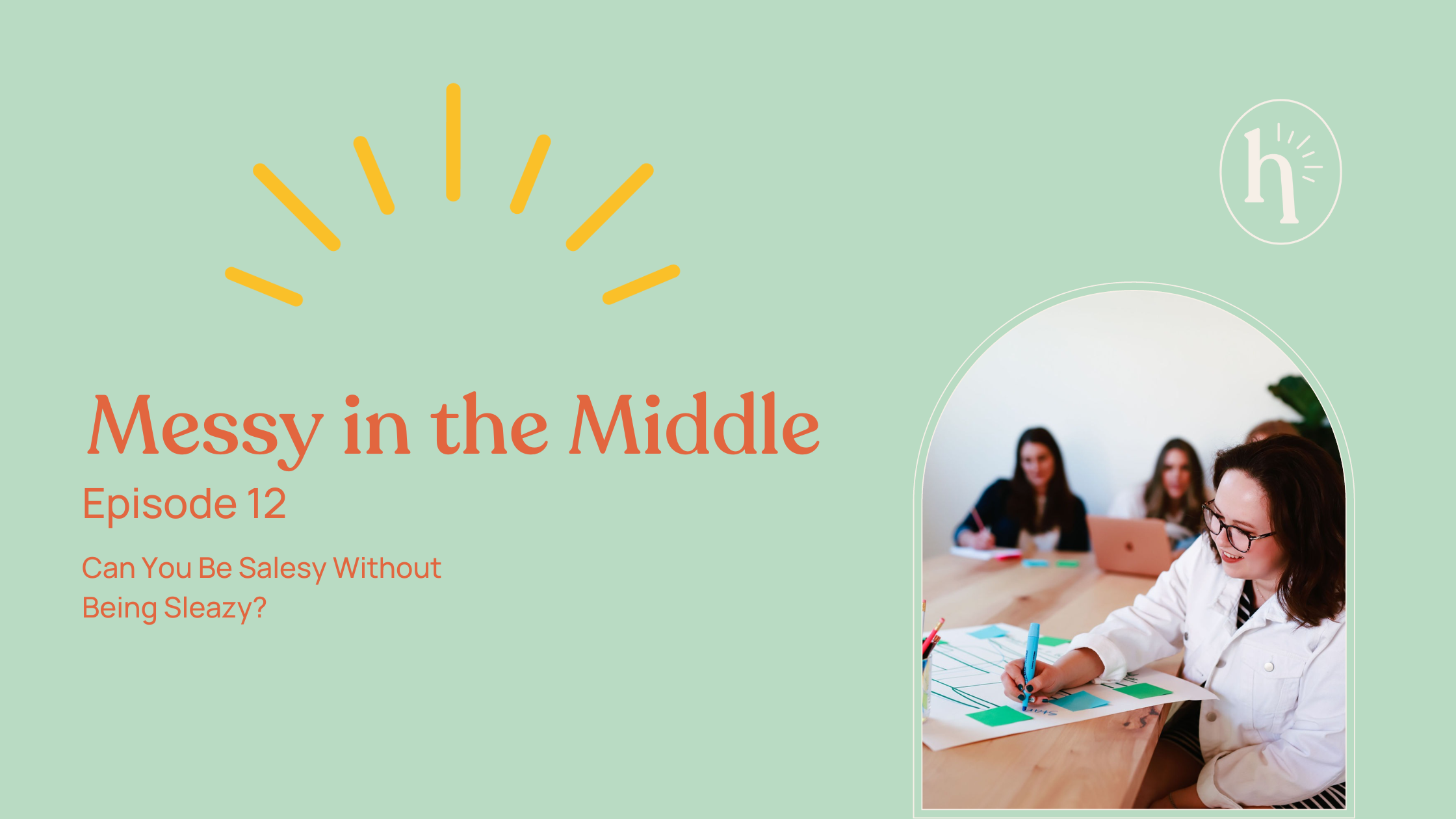Can You Be Salesy Without Being Sleazy?
A few weeks ago, I sent out a newsletter centered around the idea of how you can write sales copy without being sleazy. In the process of writing said newsletter, I did get a little carried away in my research and some of the content was too good to keep to myself! In this post, I want to talk all about persuasion, sales psychology, and ask the big question- can you be salesy without being sleazy?
What Is Sales Copy?
HubSpot defines sales copy as text written to sway customers into taking specific actions and can be used to persuade readers to buy a product, sign up for a mailing list, download content, or take any further action that will help your business achieve its sales goals. In that definition, we start to think about persuasion. I looked up the definition for persuasion and it does that annoying thing where it just uses the word to define the word. Instead, we’ll talk about some synonyms. We’ve got: convince, coerce, encourage, urge, entice, pressure, and tempt.
Just based on these words, you can see that before we even attach any emotion or context to the idea of persuasion and sales copy, it already leans towards something slimy. If we dig deeper into what makes sales copy persuasive, we can uncover what makes the idea of sales copy feel slimy and why. But first, let’s make a pit stop at sales psychology.
What is Sales Psychology?
Sales psychology is defined by Business.com as a type of process that involves considering the psyche of your target market to sell your products and services. Instead of saying “you need this, you need this, you need this,” and just hoping your target market will buy, sales psychology uses persuasive elements to tap into the target market psyche and create an environment, interaction, or piece of copy that convinces, encourages, entices, pressures, or attempts, (aka persuades) the target customers to buy the product or service.
This is done by applying some or all of the six key principles of sales psychology: reciprocity, commitment and consistency, social proof, liking, authority and scarcity.
Let’s be clear: no one of these principles is inherently wrong. But as we move through the meaning of each, we can unpack some of the ethical and not so ethical ways we see these principles being illustrated in the world around us. By doing this, we can begin to develop an educated understanding of how and when each principle can be applied in our own sales strategies in a way that is supportive and not sleazy.
Can You Be Salesy Without Being Sleazy?: The 6 Key Principles of Sales Psychology
Scarcity
I know I said it last, but let’s start with probably the most polarizing of the principles: scarcity. We see scarcity applied all the time in marketing. This varies from limited spots in a program, a countdown signaling the end of a sale, or the closing of an enrollment period.
Scarcity is similar to the economic principle of supply and demand. As supply increases, demand decreases. But as supply decreases, demand increases. Scarcity, whether real or artificial, represents a decrease in supply that encourages buyers to take action and make a purchase.
But when is scarcity an ethical sales tactic and when does it drift over into slimy territory? Of course, the answer is, it depends. Nuance is everything, especially when it comes to ethics. I find that the easiest line to draw is the one between genuine and artificial or manufactured scarcity.
Imagine walking into your favorite coffee shop, and they tell you they only have one of your favorite pastries left. It’s at a special price because it’s the last one, and they’re never going to order these pastries again. It’s the last opportunity you’ll have to buy that pastry at that shop. You can’t pass that up. That is genuine scarcity. The quantity is limited, time is confined, and once that pastry is gone, there won’t be any more. So, you better decide if you want it, and you better decide fast.
But imagine you order that pastry, sit down in the corner of the coffee shop, and see the barista put another one in the case. The next person who walks up to the counter hears exactly what you did. “It’s the last one. It’s a special price.They’re never ordering them again.”
How do you feel about that? Probably a little uncomfortable, right? Maybe you were going to buy a pastry anyway, but you only bought that one because of the deal. Or maybe you were trying to avoid pastries this morning, but you didn’t want to miss out on the last chance to have your favorite. Or maybe you were going to buy that exact pastry anyway, no matter the price, but you just feel kind of weird knowing that the barista lied to you about it.
This example may be a bit exaggerated and silly, but it illustrates what happens in our minds when we uncover false scarcity. There’s an element of disappointment when we realize we made a decision that went against our initial plan for the day or even one that went against our best interest.
Reciprocity & Liking
We can look at reciprocity and liking together because they are often used in conjunction with one another. Liking is simply the idea that we are more likely to buy from someone we like i.e. if we find them attractive, we think they’re kind, they’re funny. Reciprocity is the idea that once we give someone something, they are more likely to return the favor and give us something: a sale. One place we see these two principles working together is in influencing.
We follow influencers because we like them, they’re attractive, live aspirational lifestyles and provide us with some form of entertainment through their content. As a way to reciprocate the entertainment they provide, we purchase items they share using their affiliate links, support their branded content and return the favor by helping our favorite influencers earn a living. If we didn’t have the initial exchange of the influencer providing us with entertainment, we likely wouldn’t be motivated to purchase the items they promote.
In business, this can be applied as directly as purchasing merch from a band or creator that you like because they’ve provided you with entertainment. If someone has a podcast you like and get value from, when they have a launch or promotion you want to purchase and support them. When you get a free trial or consultation call from a service provider or membership, you’re more likely to begin a paid subscription or sign up for a paid service because you’ve been given value and want to return the favor.
Authority
By definition, authority is the power or right to give orders, make decisions and enforce obedience. And I don’t know about you, but I don’t exactly want my clients and students feeling like they need to obey me in order to be successful or obey me at all. Even if we look at establishing authority like buying a one way ticket to Sleaze City, we can still examine the goal of establishing authority and discover more supportive ways to reach that goal in our sales copy.
The idea behind authority is that people are more likely to be convinced to purchase by someone they believe holds more knowledge or power than they do. This positions them as a reliable source. Instead of focusing on establishing authority to dominate the decision making process for our ideal buyers, let’s focus on establishing credibility.
How do we establish credibility through education and our fifth element of sales psychology? Social proof.
Social Proof
Rather than focusing on content that establishes our authority and social proof that doubles down on that position, we can support our sales process by creating content that educates our audience in our areas of expertise. By citing reliable sources to show we’ve done our research, social proof will continue to prove that we can translate what we are trying to convey.
We establish authority by proving credibility and using social proof to help potential buyers feel confident in the decision they came to on their own accord, not because they felt they needed to obey us when we told them to purchase.
Commitment & Consistency
Last but not least, we have commitment and consistency. This is the theory that people like to be consistent, so once we can get them to start or try something, it’s easier to get them to continue in in-person sales. This can look like asking yes or no questions that have yes is the obvious answer so when it comes time to close the sale, the prospect is used to saying yes and is more likely to say yes to the sale.
This can manifest in plenty of ways in sales copy, but the first thing that always comes to mind for me is the section of a sales page that starts with “have you ever wanted to?” It then goes on to list things like having more freedom, making more money, and loving what you do every day before leading to a buy button for a program that promises to help you along that path.
Incorporating These Principles Into Your Copy
There are a ton of different ways to incorporate any combination of the six principles of sales psychology into your own sales copy and there is no right or wrong way to go about it. When you work on writing your next sales page, email campaign or social media promo, I recommend asking yourself the following questions:
How many principles of sales psychology am I applying to this promotion?
Does this feel appropriate for the type of sale I’m trying to make?
If I layer on the persuasion and someone feels compelled, convinced, tempted, persuaded, etc. to make a choice that isn’t right for them in the long term, what will the consequences of that be? Will they ask for a refund? What if they overdraft their bank account? Will they need to borrow money from someone to make ends meet?
If we start seeing or imagining these potentially serious negative consequences of someone being too persuaded by our sales psychology, maybe we pull back on some of the persuasion.
How to Avoid Sounding Sleazy
If something feels sleazy, break it down. When you’re writing your sales copy and you’re thinking, “ this is starting to get weird,” think about what feels weird to you. Which principle is it most connected to? What about it feels sleazy? Is there a way that you can pivot the copy so it feels better? Or do you want to just not focus on that principle? If something doesn’t feel right to you, you are under no obligation to include it in your sales strategy, even if it’s what the gurus or the sales professionals are telling you you need to do. At the end of the day, if you don’t feel good selling, then it’s not going to be a successful sale.
What If It’s Just Selling?
Finally, you should ask yourself if there is something else about selling that feels icky to you. Maybe it’s not the copy! Maybe you’re worried about putting yourself out there, or maybe you aren’t excited about actually delivering on the offer you’re trying to sell. It’s easy to blame sales tactics for not liking sales, but when we take the time to ensure we are implementing sales tactics that do feel good to us, it’s equally as important to pull back and understand what, if anything, else isn’t clicking. There might be underlying reasons besides just the copy, and the copy is a really easy thing to blame.
Can You be Salesy Without Being Sleazy?: The Wrap Up
I hope you enjoyed the accidental rabbit hole I went down when writing that newsletter much as I did. If you want to get more first looks at podcast episodes, I encourage you to sign up for my weekly Ish newsletter, Mostly Thursdays. If you’re interested in giving your own sales copy a once over, you can send me a DM over on Instagram, and I can tell you all about my new copy audit, The Gutcheck!




